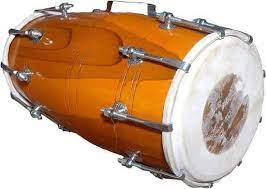
"Dolak: The Rhythmic Heartbeat of Cultural Resonance"
In the vibrant world of percussion instruments, the Dolak emerges as a cultural icon—a versatile drum steeped in tradition and revered for its resonant beats that echo through diverse musical landscapes. Originating from India, particularly South India, the Dolak's rhythmic prowess and melodic resonance have made it an integral part of cultural celebrations, folk music, and classical ensembles. Let's delve into the rhythmic journey of the Dolak, exploring its origins, design, playing techniques, cultural significance, and enduring allure.
Historical Heritage:
Ancient Roots:
The Dolak's origins can be traced back centuries, rooted in the rich musical traditions of South India, particularly Tamil Nadu and Karnataka, where it found a place in temple rituals and cultural celebrations.
Design and Construction:
Unique Structure:
The Dolak features a distinctive hourglass-shaped body with two drumheads—one on each side—typically made of animal skin or synthetic material, stretched over hollow wooden shells.
Versatile Tones:
The drum's tunable nature allows for a wide range of tonal variations, from deep bass tones to crisp trebles, offering a versatile palette for rhythmic expression.
Playing Techniques:
Rhythmic Mastery:
Dolak players utilize a variety of techniques, including finger tapping, palm strokes, and nuanced hand movements, to produce intricate rhythms, beats, and patterns.
Melodic Infusions:
Beyond rhythmic cadences, Dolak players incorporate melodic elements by modulating the tension of the drumheads, adding tonal richness to their performances.
Cultural Significance:
Folk Traditions:
The Dolak holds immense cultural significance in folk music, accompanying traditional dances, processions, and storytelling, serving as a rhythmic anchor in cultural narratives.
Classical Ensemble:
In classical Carnatic music, the Dolak often accompanies vocalists, instrumentalists, and dance performances, adding rhythmic depth and dynamics to the compositions.
Enduring Legacy:
Evolving Presence:
While rooted in tradition, the Dolak's presence has expanded into contemporary music, fusion genres, and collaborations, showcasing its adaptability and versatility.
Conclusion: Rhythmic Resonance, Cultural Echoes
The Dolak, with its resonant beats and rich heritage, embodies the soulful rhythms and cultural vibrancy of South India. Its rhythmic cadences, created through deft hand movements and melodic infusions, weave a tapestry of cultural narratives—a testament to the enduring allure and rhythmic richness of this esteemed drum, echoing through generations.
As the Dolak's beats resound through festive celebrations, classical concerts, and collaborative performances, they encapsulate the enduring legacy and rhythmic heartbeat of this cherished percussion instrument—a testament to its cultural significance and rhythmic resonance in the world of music.
The Dolak, with its rhythmic complexity and cultural heritage, remains an essential part of South Indian music, embodying the soulful beats and rhythmic vibrancy that resonate through cultural celebrations, folk traditions, and classical performances.
ABOUT AUTHOR : Musicintuit Admin
EXPLORE OUR ARRAY OF ONLINE MUSIC COURSES: Musicintuit Courses
ENROLL TODAY ! EXPLORE AND IMMERSE YOURSELF IN THE REALM OF MUSIC: Contact Musicintuit




